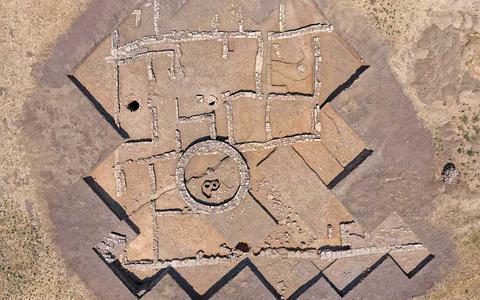Photos: ethnos.gr
An impressive house of the classical era (5-4th century BC) with multiple objects, including bronze and silver coins, loom weights, figurines, jewellery and a significant amount of pottery and amphorae were discovered by archaeologists in Molivoti in Rodopi. Many scholars identify this village with the ancient settlement of Strimi that was established in the 7th century BC.
Two wells have been discovered inside the house and cleaned, and ceramics from the second half of the 6th century BC below the level of the foundations. The house itself was abandoned in the last quarter of the 4th century or early 3rd century BC.

The construction materials were reused in the middle of the 4th-5th century AD and the last period when the house was used was from the second half of the 5th century to the mid-6th century AD, when a circular building with a diameter of 6 metres was erected over the former building.
The excavations were conducted by the commission for ancient discoveries of the Rodopi area and the Department of Classical Studies at Princeton University. Despina Terzopoulou and Marina Tasaklaki were in charge of them from the Greek side and Prof. Nathan Arrington from the American side.

Aerial photos of the house from the classical era
The excavations have been completed and now archaeologists are examining their findings with a view to their publication, which will happen in about three years.
Scientists note that not all experts accept the identification with Strimi as no inscriptions have been found. The first findings from the area of Molivoti were made in the early 20th century. During World War I, Bulgarian soldiers dug trenches along the coast of Thrace and in the 1950s, Thessaloniki University professor George Bakalakis carried out the first systematic research and excavations in the area, stating that the settlement was Strimi.
The repeated use of the site largely destroyed the classic house. For this reason, archaeologists are unable to determine exactly the internal arrangement and use of each room.

"Although we cannot yet state with certainty that we are excavating the ancient settlement of Strimi, today we know much more about its structure and the history of its establishment and abandonment. The strong presence of red-figured Attic pottery from the 5th century BC, fragments of black glazed and unglazed pottery from the 4th century BC, as well as the numerous pieces of commercial amphorae of Thasos, Mendi, Lesvos, Chios, are helping us to restore the network of commercial links of this Greek colony on the coast of Thrace. The fact that many coins from the 5th-4th century BC were issued by the Maronia mint shows the close relationship of the two cities, which ancient sources also confirm," said Terzopoulou and Tasaklaki.
The north and west side of the village is surrounded by a wall. The area between the walls is about 470 acres, but part of the city towards the east is lost in the sea. Parts of houses and roads, but not of public buildings, have been discovered as well as a small part of the city water-conduit and two ports, and graveyards to the north and west of the walls.